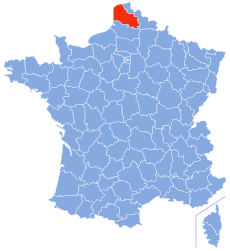Operation Collar (commando raid) facts for kids
Quick facts for kids Operation Collar |
|||||||
|---|---|---|---|---|---|---|---|
| Part of Second World War, the North West Europe Campaign | |||||||
 Map of France the Pas-de-Calais highlighted in red |
|||||||
|
|||||||
| Belligerents | |||||||
| Commanders and leaders | |||||||
| Major Ronnie Tod | Unknown | ||||||
| Strength | |||||||
| 115 officers and other ranks | Unknown | ||||||
| Casualties and losses | |||||||
| One wounded | Two dead | ||||||
Operation Collar was the secret name for the very first commando raid by British forces during World War II. It took place on the French coast, in a region called Pas-de-Calais. The British Commandos were a new group, not yet fully trained. So, a unit called No. 11 Independent Company, led by Major Ronnie Tod, was chosen for this mission.
Their main goals were to scout four different places and capture German soldiers for information. On the night of June 24-25, 1940, 115 men from No. 11 Independent Company carried out the raid. They didn't gather much information or damage German equipment. Their only success was killing two German guards.
Contents
Why the Raid Happened
Creating the Commandos
After the British Expeditionary Force was evacuated from Dunkirk in 1940, Prime Minister Winston Churchill wanted to strike back. He asked for a special force to be created. This force would attack the Germans and boost British spirits.
Churchill told his military leaders to plan attacks on German-occupied Europe. He said they needed "specially trained troops of the hunter class." These troops would "develop a reign of terror down the enemy coast."
The Idea for Special Forces
A staff officer named Lieutenant-Colonel Dudley Clarke had already suggested such a plan. He shared his idea with General Sir John Dill, who was a top army leader. Dill knew what Churchill wanted, so he approved Clarke's idea.
These new special forces were called the Commandos. They were managed by the Combined Operations Headquarters. The first leader chosen for the Commandos was Admiral Sir Roger Keyes. He was a hero from earlier wars.
Finding Volunteers
In 1940, the call went out for volunteers. Soldiers already serving in Britain could join. Men from special "Independent Companies" that were being disbanded also volunteered. These companies had fought in Norway. By the autumn of 1940, over 2,000 men had volunteered for commando training.
Planning Operation Collar
Prime Minister Churchill was eager for raiding operations to begin. So, the Combined Operations Headquarters quickly planned Operation Collar. The main goal was to scout the French coast and capture German prisoners.
This raid happened just three weeks after Operation Dynamo, the evacuation from Dunkirk. France had also just signed a peace agreement with Germany on June 22, 1940. The new British Commandos were not yet fully trained. Many units still needed more soldiers. So, No. 11 Independent Company was chosen. This unit was led by Major Ronnie Tod.
The Mission Details
Getting Ready for the Raid
No. 11 Independent Company was chosen for the first commando raid on occupied France. They moved from their base in Scotland to Southampton, a port city in southern Britain. There, they practiced against a local army group.
During these practices, the soldiers found that their boats were not good enough. They couldn't cross the English Channel safely. Since they didn't have their own boats, they asked the Royal Air Force (RAF) for help. The RAF lent them four air sea rescue boats from Dover, Ramsgate, and Newhaven.
Landing on the Coast
The raid involved 115 officers and soldiers. They were split into four groups. Each group would land on a different beach: Neufchâtel-Hardelot, Stella Plage, Berck, and Le Touquet. They were told to stay ashore for no more than 80 minutes.
The RAF boats were not made for this kind of mission. They didn't have good navigation tools, and their compasses were not reliable. As they crossed the channel, RAF planes on patrol noticed them. The planes didn't know about the secret mission and flew close to investigate. Around 2:00 AM on June 24, 1940, the boats reached France and dropped off the men.
What Happened Ashore
The group that landed at Le Touquet aimed for the Merlimont Plage Hotel. British intelligence thought Germans were staying there. But when the group reached the hotel, it was empty. The doors and windows were boarded up. They couldn't find another target.
They returned to the beach, only to find their boat had gone back out to sea. While waiting, two German guards found the group and were quietly killed. Another German patrol then approached. The group had to swim out to their boat, leaving their weapons behind.
The group at Hardelot went inland a few hundred yards. They returned to their boat without seeing any Germans. The men at Berck found a seaplane base. But it was too heavily guarded for them to attack. The last group landed at Stella Plage, led by Major Tod. They met a German patrol. In a short fight, one British soldier was slightly wounded.
After the Raid
Official Statement
After the raiders returned safely to England, the Ministry of Information released a statement:
| "Naval and military raiders, in cooperation with the RAF, carried out successful reconnaissances of the enemy coastline: landings were effected at a number of points and contacts made with German troops. Casualties were inflicted on the enemy, but no British casualties occurred, and much useful information was obtained". |
Mixed Results
Operation Collar had mixed results. The British killed two German guards. The only British injury was to Lieutenant Colonel Dudley Clarke, who was observing the raid. He received a slight wound at Stella Plage.
Even with its limited success, this first commando operation made an impact. Within a year, Adolf Hitler spoke about the commandos. He called them "terror and sabotage troops" who "acted outside of the Geneva convention" (rules of war).

